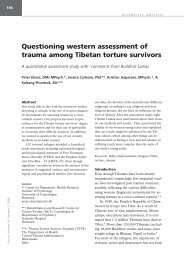- Page 1 and 2:
MTV om behandling og rehabilitering
- Page 4 and 5:
MTV om behandling og rehabilitering
- Page 6 and 7:
Indholdsfortegnelse Forord . . . .
- Page 8 and 9:
Indholdsfortegnelse 6.3. Internatio
- Page 10:
Forord Bedre hjælp til traumatiser
- Page 14 and 15:
Abstract Immigrants including refug
- Page 16:
Anna Marie Erbs Behandlingsleder, R
- Page 19 and 20:
1.1. Baggrund for rapporten Behandl
- Page 21 and 22:
Tilgangen til behandling og rehabil
- Page 23 and 24:
1.5. Afgrænsning af teknologien Af
- Page 25 and 26:
Kapitel 9 indeholder de samlede anb
- Page 27 and 28:
I det omfang, sekundærlitteraturen
- Page 29 and 30:
Tabel 2: Opfølgende søgninger . P
- Page 31 and 32:
Udvælgelse af identificerede studi
- Page 33 and 34:
2.5. Vurdering af litteratur Efter
- Page 35 and 36:
3.1. Flygtninge, PTSD og sundhedsv
- Page 37 and 38:
Behandling af PTSD har hidtil i beg
- Page 39 and 40:
Effekten af tværfaglige behandling
- Page 41 and 42:
De nuværende diagnostiske klassifi
- Page 43 and 44:
Stress i de unges hjem varierede fr
- Page 45 and 46:
4.2.1. Traumedosis og PTSD Omfanget
- Page 47 and 48:
Det interessante ved denne undersø
- Page 49 and 50:
Især type A + C-tilknyttede (U hos
- Page 51 and 52:
arnets fokus fra ubehagelige og sme
- Page 53 and 54:
Helweg Larsen har undersøgt indvan
- Page 55 and 56:
4.2.4. Resiliens - og sårbarhedsst
- Page 57 and 58:
4.2.6. Forløb og prognose af PTSD
- Page 59 and 60:
4.3. Co-morbiditet Den tilgængelig
- Page 61 and 62:
De noget arbitrære konsensusbasere
- Page 63 and 64:
Figur 5: Hjernediagram ’ Orbitofr
- Page 65 and 66:
Konkluderende om Co-morbiditet Den
- Page 67 and 68:
4.4. Fysiske konsekvenser af PTSD E
- Page 69 and 70:
4.5. Sociale konsekvenser af PTSD I
- Page 72 and 73:
5. Teknologien Teknologiafsnittet i
- Page 74 and 75:
Skema 3: Teknologi; farmakologiske
- Page 76 and 77:
5.2. Psykosocial behandling I 1997
- Page 78 and 79:
CPT viste bedre resultater end vent
- Page 80 and 81:
Disse undersøgelser peger på den
- Page 82 and 83:
life) før og efter ni måneders us
- Page 84 and 85:
5.4. Faktorer, der har betydning fo
- Page 86 and 87:
Generelt viser studier, at patiente
- Page 88 and 89:
5.4.2. Betydningen af patientens ps
- Page 90 and 91:
og hertil oftest problemer med live
- Page 92 and 93:
Allen og medarbejdere har udviklet
- Page 94 and 95:
Den foreliggende evidens peger på
- Page 96 and 97:
LEAS score korrelerede positivt med
- Page 98 and 99:
5.8. Psykofarmakologisk behandling
- Page 100 and 101:
Figur 9: Gyrus cinguli anteriors te
- Page 102 and 103:
Skønt PTSD patienter udviser lave
- Page 104 and 105:
5.8.2. Det Adrenerge system, noradr
- Page 106 and 107:
SSRI er bedst dokumenteret og er bl
- Page 108 and 109:
(451) og Goldberg et al. (452). Dis
- Page 110 and 111:
5.8.7. Psykosocial behandling af PT
- Page 112 and 113:
5.9. Konklusion vedr. psykofarmakol
- Page 114 and 115:
Dette repræsenterer en betydelig u
- Page 116 and 117:
Eftersom grupperne var ens grundet
- Page 118 and 119:
Litteraturstudiet og efterfølgende
- Page 120:
Derfor gælder terapien om at træn
- Page 123 and 124:
Hvis et center skal være effektivt
- Page 125 and 126:
Før et center kan karakteriseres s
- Page 127 and 128:
Centerstrategien definerer, hvordan
- Page 129 and 130:
Medmindre patienten er tydelig suic
- Page 131 and 132:
54 Her tales om hospitalsbaseret be
- Page 133 and 134:
Figur 13: Det konsulterende centers
- Page 135 and 136:
Individuel, familiemæssig og grupp
- Page 137 and 138:
Ethvert teoretisk fundament er vide
- Page 139 and 140:
Støtte (advocacy) En stor del af s
- Page 141 and 142:
Det ideelle forhold mellem patient
- Page 143 and 144:
Det ideelle specialiserede behandli
- Page 145 and 146:
Personale Medarbejderne på ethvert
- Page 147 and 148:
Ledelse og management I det ideelle
- Page 149 and 150:
Forebyggelse I en ideel verden har
- Page 151 and 152:
Centrets medarbejdere kan, som case
- Page 153 and 154:
6.3. Internationale erfaringer med
- Page 155 and 156:
Den anden model - også kaldet Unif
- Page 157 and 158:
6.4. Behandlingsformer Evidensen fo
- Page 159 and 160:
I forhold til antallet af behandlin
- Page 161 and 162:
I undersøgelsen deltog i alt 87 bo
- Page 163 and 164:
ikke foretaget samtidigt, hvorfor f
- Page 165 and 166:
Problemet hermed er, at kun en del
- Page 167 and 168:
En særlig forskel i de danske og i
- Page 169 and 170:
Baseret på den færdigudfyldte pro
- Page 171 and 172:
Samarbejde med socialforvaltningen.
- Page 173 and 174:
Den mest interessante sammenligning
- Page 175 and 176:
6.16. Forebyggelse Figur 16: En sti
- Page 177 and 178:
Af særlig værdi i fremtiden vil v
- Page 179 and 180:
I mangel heraf klarer mange patient
- Page 181 and 182:
7.2. Patienttilfredshed og præfere
- Page 183 and 184:
Formålet med det første studie (5
- Page 185 and 186:
Nogle af de mange resultater, som m
- Page 187 and 188:
7.3. Patienttilfredshed og præfere
- Page 189 and 190:
I dansk sammenhæng har man unders
- Page 191 and 192:
Om psykoterapeutisk arbejde med tra
- Page 193 and 194:
Om forskning og evidens i behandlin
- Page 195 and 196:
Figur 18 og 19: Følelsesmæssige r
- Page 197 and 198:
Studie Aldersgruppe Studie af Præv
- Page 199 and 200:
Tolken kan både virke som positiv
- Page 201 and 202:
7.4.3. Behandling Terapeuter, der b
- Page 204 and 205:
8. Økonomien 8.1. Introduktion Det
- Page 206 and 207:
8.4. Litteraturgennemgang af omkost
- Page 208 and 209:
end hos dem der blev behandlet for
- Page 210 and 211:
De generelle resultater peger på,
- Page 212 and 213: Kendetegnende for begge studier er,
- Page 214 and 215: Desuden viste den langvarige behand
- Page 216 and 217: 8.6. Konklusion vedr. økonomi Samm
- Page 218 and 219: 9. Anbefalinger Anbefalingerne i de
- Page 220 and 221: gennem regulering af kropsreaktione
- Page 222 and 223: Organisering af behandling bør str
- Page 224 and 225: 9.7. Anbefaling vedr. forskning og
- Page 226 and 227: med lidelsen samt traumetypens indf
- Page 228: 10. Bilag 10.1. Bilagsfortegnelse 1
- Page 232: Indhold Baggrund MTV-spørgsmål In
- Page 236: 2. MTV spørgsmål Nedenstående er
- Page 240 and 241: 4. Databaser, søgestrategier og re
- Page 242 and 243: PubMed http://www.ncbi.nlm.nih.gov/
- Page 244 and 245: Cinahl (WebSpirs) 16 . marts 2008 #
- Page 246 and 247: National Guidelines Clearinghouse h
- Page 248 and 249: Cinahl (WebSpirs) 20 . april 2008 #
- Page 250 and 251: # 13 ‘Physical-Therapy’ in MJ,M
- Page 252 and 253: # 12 #5 and #6 and #11 (1 record) #
- Page 254 and 255: Organisation HTA database 14 . juli
- Page 256 and 257: Socialstyrelsen, Sverige (1 fund) w
- Page 258 and 259: Bilag 2: AGREE-instrumentet til kva
- Page 260 and 261: Anvendelighed 19. Potentielle organ
- Page 264 and 265: 1. Stilles der et veldefineret stud
- Page 266 and 267: Bilag 5: ICD-10 diagnostiske kriter
- Page 268 and 269: Bilag 6: DSM-IV-TR diagnostiske kri
- Page 270 and 271: Bilag 7: Anbefalede DSM diagnostisk
- Page 272 and 273: Økonomisk evaluering kan defineres
- Page 274: Det randomiserede, kontrollerede fo
- Page 277 and 278: (12) National Collaborating Centre
- Page 279 and 280: (36) Helweg-Larsen K, Kastrup M. Ko
- Page 281 and 282: (61) Norris FH, MAD, Baker CK, Peri
- Page 283 and 284: (87) Teicher MH, Andersen SL, Polca
- Page 285 and 286: (110) Schore AN. The emotional and
- Page 287 and 288: (132) Stern JM. Offspring-induced n
- Page 289 and 290: (155) Burns BJ, Phillips SD, Wagner
- Page 291 and 292: (177) Kaysen D, Scher CD, Mastnak J
- Page 293 and 294: (200) Back SE, Sonne SC, Killeen T,
- Page 295 and 296: (222) Dahlbender RW, Rudolf G, The
- Page 297 and 298: (246) Allen JG, Fonagy P, Bateman A
- Page 299 and 300: (269) Fecteau G, Nicki R. Cognitive
- Page 301 and 302: (290) Levine P. Væk tigeren. Helbr
- Page 303 and 304: (314) Birck A. Symptomatik bei krie
- Page 305 and 306: (338) Fearon P, Target M, Sargent J
- Page 307 and 308: (361) Giesen-Bloo J, Van Dyek R, Sp
- Page 309 and 310: (384) Bremner JD, Licinio J, Darnel
- Page 311 and 312: (406) Kolb LC, Burris BC, Griffiths
- Page 313 and 314:
(428) Seedat S, Lockhart R, kaminer
- Page 315 and 316:
(452) Goldberg JF, Cloitre M, White
- Page 317 and 318:
(477) Lieberman MD, Eisenberger NI.
- Page 319 and 320:
(501) Gavrilovic JJ, D’ardenne P,
- Page 321 and 322:
(525) Cacioppo JT, Patrick W. Lonel
- Page 323 and 324:
(549) Kinzie JD, Boehnlein JK. Psyc
- Page 326 and 327:
12. Referencer - alfabetisk Referen
- Page 328 and 329:
Ballenger, J. C., Davidson, J. R. T
- Page 330 and 331:
Bichescu, D., Neuner, F., Schauer,
- Page 332 and 333:
Bremner, J. D., Vythilingham, M., V
- Page 334 and 335:
Chard, K. M. 2005, ”An evaluation
- Page 336 and 337:
Dansk Flygtningehjælps Center for
- Page 338 and 339:
Diamond, D. & Yeomans, F. E. 2007,
- Page 340 and 341:
Evidence and Research Department of
- Page 342 and 343:
Fonagy, P. 2008, ”Foreword.,” i
- Page 344 and 345:
Fries, A. B., Ziegler, T. E., Kuria
- Page 346 and 347:
Gyllensten, A. L., Hansson, L., & E
- Page 348 and 349:
Holtan, N., Antolak, K., Johnson, D
- Page 350 and 351:
Kagan, J. 1994, Galen’s prophecy.
- Page 352 and 353:
Kolb, L. C., Burris, B. C., & Griff
- Page 354 and 355:
Le Doux, J. 2002, The synaptic self
- Page 356 and 357:
Loof, D., Grimley, P., Kuller, F.,
- Page 358 and 359:
Miller, K. E., Martell, Z. L., Pazd
- Page 360 and 361:
Moran, M. 2008, ”Mentalization-ba
- Page 362 and 363:
Okuyama, N., Takagi, N., Kawai, T.,
- Page 364 and 365:
Pratt, S. I., Rosenberg, S., Mueser
- Page 366 and 367:
Savin, D., Seymour, D. J., Littlefo
- Page 368 and 369:
Schwerdtfeger, K. L. & Goff, B. S.
- Page 370 and 371:
Statens beredning för medicinsk ut
- Page 372 and 373:
Tobias, G., Haslam-Hopwood, G., All
- Page 374 and 375:
Viola, J., Ditzler, T., Batzer, W.,
- Page 376:
Woodward, S. H., Kaloupek, D. G., S




